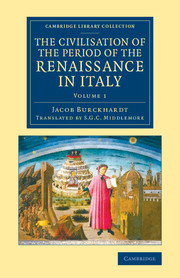Description
The Civilisation of the Period of the Renaissance in Italy
The Civilisation of the Period of the Renaissance in Italy 2 Volume Set Series
Author: Burckhardt Jacob
Burckhardt's 1860 magnum opus on the development of the Italian Renaissance, here reissued in the two-volume English translation of 1878.
Language: English
Subject for The Civilisation of the Period of the Renaissance in Italy:
Approximative price 40.64 €
In Print (Delivery period: 14 days).
Add to cart
Publication date: 12-2014
Support: Print on demand
Support: Print on demand
Description
/li>Contents
/li>
On several journeys to Italy in the mid-nineteenth century, the Swiss historian Jacob Burckhardt (1818?97) saw in the figures and events of the Italian Renaissance certain traits that he believed to be mirrored in the politics of his own day, notably some aspects of 'an unbridled egoism, outraging every right, and killing every germ of a healthier culture'. Revolutionary in his all-encompassing and unflinching examination of the Italian Renaissance, Burckhardt saw developments in statecraft and war as giving rise to the more publicised artistic progress of the era. First published in 1860, this work is considered to be his magnum opus on the subject, and is here reissued in the accessible two-volume English translation of 1878 by S. G. C. Middlemore. In Volume 1, Burckhardt considers three key themes: the state as a work of art, the development of the individual, and the revival of antiquity in education and philosophy.
Preface; Part I. The State as a Work of Art: 1. Introduction; 2. The tyranny of the fourteenth century; 3. The tyranny of the fifteenth century; 4. The petty tyrannies; 5. The greater dynasties; 6. The opponents of tyranny; 7. The republics: Venice and Florence; 8. Foreign policy of the Italian states; 9. War as a work of art; 10. The papacy and its dangers; Part II. The Development of the Individual: 1. The Italian state and the individual; 2. The perfecting of the individual; 3. The modern idea of fame; 4. Modern wit and satire; Part III. The Revival of Antiquity: 1. Introductory remarks; 2. Rome, the city of ruins; 3. The old authors; 4. Humanism in the fourteenth century; 5. The universities and schools; 6. The furtherers of humanism; 7. The reproduction of antiquity; 8. Latin treatises and history; 9. General Latinisation of culture; 10. Modern Latin poetry; 11. Fall of the humanists in the sixteenth century.
© 2024 LAVOISIER S.A.S.
These books may interest you

Judgements on History and Historians 123.79 €



